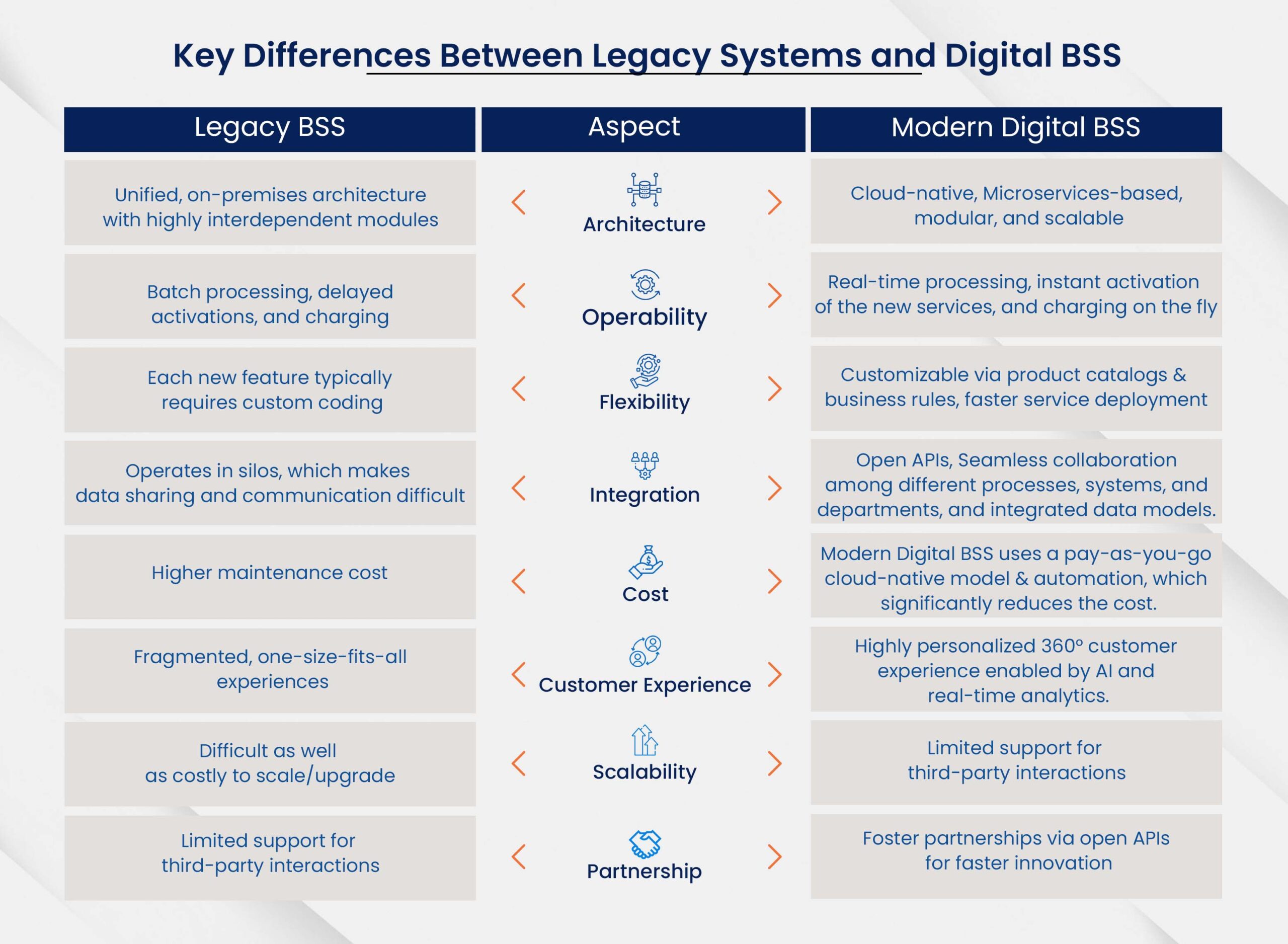Telecom operators who depend on decades-old business support systems (BSS) are battling to keep up with modern customer demands. On the other hand, a modern digital BSS for telecom is designed for agility, real-time operations, and seamless customer experiences. In this blog, we will discuss the differences between legacy BSS and digital BSS, why adopting a 5G-ready BSS track is important, and how adopting the advancements in your existing system can introduce a new set of opportunities for revenue generation.
What is a Legacy Telecom BSS?
Legacy telecom BSS is a traditional IT system that the telecom industry has been using for years to manage billing, charging, customer management, and service orders. The legacy systems were built in the traditional age of simple voice and text services. These legacy systems involved manual processes with a rigid interface, which made them slow, complex, and increasingly irrelevant in the modern telecom sector.
If we look practically, the older BSS platforms are frequently monolithic and inflexible. They can conduct key functionality, like billing and customer record-keeping. But they used to operate in silos with minimal real-time capabilities. In the meantime, telco operators have customized these systems. That resulted in a tangled web of customized integrations that are complicated to update or standardize. As a consequence, legacy BSS systems typically appeared to be inflexible, slow to change, and costly to maintain. These flaws make it harder for the telco operators to make any advancement or scale services to meet the current market demand.
What is a Digital BSS for Telecom?
A digital BSS for telecom refers to the advanced, agile, cloud-native, modular, and customer-centric support system that uses a microservices architecture while amplifying omnichannel customer experiences. This means you can access a unified view of the customer, whether they are on your application, web portal, or calling support. This modern telecom BSS solution is specifically crafted to be flexible, fast, and integrated. This digital BSS platform enables real-time updates, empowers automation, launches new features, and scales the existing ones without imposing any massive disruption.
| ➔ Hidden Charm;
● A digital BSS can retrieve real-time data about new subscribers, current service consumption by the customer, and any potential customer churn. |
Key Differences Between Legacy Systems and Digital
Understanding the difference between legacy and digital BSS is important for all the telecommunication stakeholders. Let us wheel in some of the key differences below.

| Aspect | Legacy BSS | Modern Digital BSS |
| Architecture | Unified, on-premises architecture with highly interdependent modules | Cloud-native, Microservices-based, modular, and scalable |
| Operability | Batch processing, delayed activations, and charging | Real-time processing, instant activation of the new services, and charging on the fly. |
| Flexibility | Each new feature typically requires custom coding | Customizable via product catalogs & business rules, faster service deployment |
| Integration | Operates in silos, which makes data sharing and communication difficult. | Open APIs, Seamless collaboration among different processes, systems, and departments, and integrated data models. |
| Cost | Higher maintenance cost | Modern Digital BSS uses a pay-as-you-go cloud-native model with the feasibility of automation, which significantly reduces the cost. |
| Customer Experience | Fragmented, one-size-fits-all experiences | Highly personalized omnichannel/360-degree customer experience enabled by AI and real-time analytics. |
| Scalability | Difficult as well as costly to scale/upgrade. | Easy on-demand scalability with cloud infrastructure |
| Partnership | Limited support for third-party interactions | Foster partnerships via open APIs for faster innovation (e.g., mobile payments, OTT content, etc.) |
Why Do You Need a 5G Ready BSS Stack?
The introduction of 5G is truly a blessing for the telecom sector. However, requires a powerful back-end to meet expectations.. A 5G-ready BSS stack is one that can support the new features and business models. As a key capability, 5G enables network slicing where telecom operators offer tailored virtual network slices to an enterprise’s particular needs. In contrast, legacy systems lack flexibility and real-time processing, which prevents them from managing dynamic network slicing and the huge volume of data generated by the 5G era.
5G has also introduced services like AR/VR streaming, advanced gaming, connected cars, and industrial IoT applications. These services usually require event-based or usage-based charging in real time. In comparison, legacy systems are not developed to support such future-proof services.
A 5G-ready BSS stack also refers to the adoption of technologies like network function virtualization and cloud-native deployment, AI, and automation, which aligns with how 5G networks are developed.
Benefits of Upgrading a Legacy System to Modern Digital BSS
Well, upgrading from a legacy system to a modern digital BSS could be a highly strategic investment is stronger.. Below are the fundamental benefits of upgrading to a modern digital BSS.
Faster Time-to-Market:
Digital BSS allows you to develop, test, and launch with minimal delay time. You can quickly respond to the competitive threats or market opportunities by using customizable product catalogs and workflows of modern BSS platforms.
Cost-effective
Reduce physical infrastructure costs by adopting pa ay-as-you-go cloud-based telecom BSS solution. Automation and AI services equally contribute to cost reduction by reducing manual work significantly.
360-Degree Customer Experience
Modern digital BSS for telecom can provide personalized 360-degree omnichannel customer service that actively enhances customer satisfaction. 5G BSS solution provides seamless integration across systems and customer interaction models.
Monetization Opportunity
A quick fact: A digital BSS is often known as “Revenue Booster” as it allows the telecommunication sector to monetize things that were not possible with legacy systems. A telecom BSS solution can manage the complex charging and partner settlement for models like bundling music or video streaming subscriptions with data plans and more.
This 5G-ready BSS stack also aids multi-currency and multi-party arrangements, which are important as telecom providers collaborate with content providers, IoT platform vendors, and others to provide joint offerings to end users.
Scalability
A 5G BSS solution can handle increasing growth and spikes in usage effortlessly, as this platform is developed to scale horizontally and vertically on the cloud. For example, during the COVID-19 pandemic, when network and service usage increased, telecom operators with cloud-based BSS could dynamically allocate resources to maintain service quality, whereas operators with legacy systems struggled to keep up.
The ability to onboard a huge number of new customers also reflects the utmost scalability of the modern telecom BSS solution.
In short, upgrading the existing system to a 5G-ready BSS stack can ensure that you stay competitive enough and expand access to new revenue opportunities. This investment delivers value across every dimension.. Happier customers, seamless operations, and outstanding innovation.
Conclusion
The debate of legacy systems vs Digital BSS was about business success rather than business survival. Legacy systems catered to the telecom operators well in the past. However, increasing demand for 5G services, digital marketplace, and customer expectations have outpaced legacy systems. Upgrading to a modern digital BSS for telecom is now a demand of the time.
Your organization can thrive faster while offering unmatched customer satisfaction and capitalize on new revenue streams by upgrading to a 5G BSS solution. Those who leap into modern BSS are positioning themselves to lead in the 5G era, while those who don’t risk being left behind.
If you are still using the legacy system, it’s time to upgrade to digital BSS for telecom and secure your future. Digital transformation doesn’t wait for anyone, and the advantages of a 5G-ready BSS stack are crucial to overlook.




